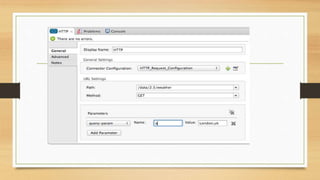The document discusses various components in Mule ESB including the File, Database, Web Service, REST, and DataWeave components.
The File component allows exchanging files with the file system and can act as an inbound or outbound endpoint. The Database component connects to relational databases using JDBC to perform SQL operations. The Web Service component allows consuming and building web services. The REST component enables configuring Mule as a RESTful service. The DataWeave component replaces the DataMapper and uses a JSON-like language to transform data.



















![• Type – To define the type of SQL statement we wish to use to submit queries
to a database :
• Parametrized – Mule replaces all MEL expressions inside the query with “?”
to create a prepared statement, then evaluates the MEL expressions.
E.g. insert into employees where name = [message.payload.name]
• Dynamic – Mule replaces all MEL expressions in the query with the result of
the expression evaluation, then sends the results to the database.
E.g. select * from #[tablename]
• From Template- It enables to define a query once globally and then reuse the
query multiple times in the same application.](https://image.slidesharecdn.com/muleesbcomponents1-160625154208-160915171456/85/Muleesbcomponents1-160625154208-20-320.jpg)


































